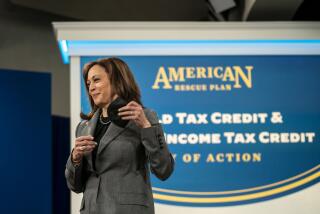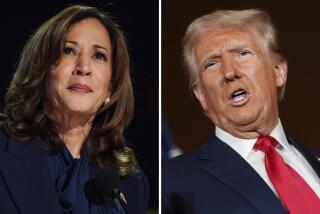Reagan’s Plan Offers Public Some Relief, but Unfairness Is Still There
- Share via
Two steps forward and one step back. That may be the best way to characterize President Reagan’s tax reform proposal.
The problem with taxes directly affecting business has not been that they have been too high. Corporate taxes, for example, now finance only eight cents of every dollar of federal expenditures, far down from the 12 cents of 1981 and the considerably higher figures of earlier years.
The problem is that they have been uneven and distortive. General Electric, Dow Chemical and Boeing and about 50 others of our very largest corporations pay no taxes at all, while many other businesses are stuck with taxes at close to the current maximum 46% rate.
A major reason that so many corporations have been getting off the tax hook has been what has amounted to huge tax subsidies directed to business investment for plant and equipment.
The Office of Management and Budget’s estimate of resulting federal revenue losses for fiscal 1986 includes $25.3 billion for the investment tax credit, $33.4 billion for accelerated depreciation and $22.1 billion for the capital gains exclusions.
These total the substantial figure of $80.8 billion.
This results in a interesting situation: For example, a business contemplating the purchase of a new machine for $100 may reason that without the tax advantage it is worth only $90 in what it can add to real productivity.
But, with the tax advantage it is worth $110, and hence the purchase is completed.
While sober estimates indicate that the tax subsidies are not even cost-efficient for the Treasury--each dollar of tax-giveaway may net only 40 cents of added capital investment.
The investment that is stimulated is thus not likely to be really productive. If it were, it would have been undertaken without the tax incentive.
Treasury I, the tax reform proposal put forth last November, was aimed at subjecting “real economic income from all sources to the same tax treatment” and ensuring that “no longer will the nation’s scarce economic resources--its land, its labor, its capital and its inventive genius--be allocated by the tax system, instead of by market forces.”
Cut Depreciation
It went remarkably far in wiping out these tax distortions affecting investment.
It not only eliminated the investment tax credit but also cut depreciation to “economic depreciation,” based on actual useful lives of assets, with adjustment for inflation.
The President’s proposal would largely reinstate, if not expand, his Accelerated Cost Recovery System (which since 1981 has allowed companies to write off the costs of plant and equipment faster than under a previous law), thus restoring billions of dollars of tax savings to capital-intensive business--not all business--along with the associated tax distortions affecting investment.
Similarly, Treasury I would have taxed all of true, realized capital gains--that is, those over and above inflation--as ordinary income. President Reagan would return to exclusion from taxable income half of capital gains on stock equity.
These retreats from the general principles of equitable and efficient tax reform are large compared to the much publicized cave-in to the gas and oil industries, where the federal tax subsidies, by OMB estimate, were a mere $2 billion. These retreats are the more striking, however, in view of the resistance to pressure on the elimination of state and local tax deductions, which currently involve federal tax revenues of $10.7 billion on property taxes on owner-occupied homes and $24.6 billion on other non-business state and local taxes. The tax deductions have been a substantial subsidy to those owning their own homes.
The deductions have also made it easier for state and local governments to raise the taxes to finance their services of police and fire protection, roads and sanitation and education and public welfare.
Coupled with budgetary proposals to end revenue sharing, they would be a heavy blow to local government services that some consider essential to a productive labor force and to the efficient operation of private business.
Compared to the current tax law, however, Reagan’s proposal must in general be rated a significant improvement. One can dismiss his Hollywood hype about “a second American Revolution” and still recognize major gains from the reduction in tax rates made possible by broadening of the tax base.
Cuts in Rates
The cuts in personal income tax rates should reduce, although hardly eliminate, the distortion in business activity induced by individual demand for tax shelters and tax-free income. The cuts in corporate tax rates coupled with elimination of the investment tax credit and a number of business deductions will reduce the degree of government favoritism in the business world and encourage business decisions for real economic gain rather than tax advantage.
But after the high promise of Treasury I, it seems a pity that so much has been given back to those special interests the President apparently favors.
One can hope that Congress will pick up former Treasury Secretary Donald T. Regan’s word processor and restore more of the sound principles and equity of Treasury’s original plan.
More to Read
Get the L.A. Times Politics newsletter
Deeply reported insights into legislation, politics and policy from Sacramento, Washington and beyond. In your inbox three times per week.
You may occasionally receive promotional content from the Los Angeles Times.










